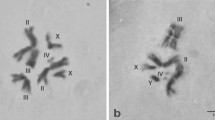Summary
A compound third chromosome strain of D. melanogaster was evaluated for population control potential in the laboratory and field. In the laboratory, the compound strain can replace a wild-type strain at release ratios above 4 compounds: 1 wild-type, but the compound strain proved to be ineffective in the field because of an inability to utilize tomatoes for oviposition sites.
Similar content being viewed by others
Literature
Baldwin, M., Chovnick, A.: Autosomal half-tetrad analysis in Drosophila melanogaster. Genetics 55, 277–293 (1967).
Childress, D.: Changing population structure through the use of compound chromosomes. Genetics 72, 183–186 (1972).
Curtis, C.: A possible method for the control of insect pests with special reference to tsetse flies (Glossina spp.). Bull. Entomol. Res. 57, 509–523 (1968).
Foster, G., Whitten, M., Prout, T., Gill, R.: Chromosome rearrangements for the control of insect pests. Science 176, 875–880 (1972).
Lefevre, G., Jonsson, U.: Sperm transfer, storage, displacement, and utilization in Drosophila melanogaster. Genetics 47, 1719–1736 (1962).
Long, T.: Genetic effects of fluctuating temperature in populations of Drosophila melanogaster. Genetics 66, 401–416 (1970).
Mason, H.: Baited traps for sampling Drosophila populations in tomato field plots. J. Econ. Entomol. 56, 897–899 (1963).
Mason, H., Henneberry, T., Gibson, H.: Attractiveness of insecticide baits to adults of Drosophila melanogaster. J. Econ. Entomol. 56, 725–727 (1963).
Mason, H., Dorst, H.: Controlling Drosophila flics on tomatoes grown for canning. USDA Farmers Bull. 2189, 12pp. (1962).
Serebrovskii, A.: On the possibility of a new method for the control of insect pests. Zool. Zh. 19, 618–630 (1940).
Stoner, A., Mason, H.: Methods of selecting tomatoes for Drosophila resistance. J. Am. Soc. Hort. Sci. 94, 396–400 (1969).
Waterhouse, D., LaChance, L., Whitten, M.: Use of autocidal methods. Ch. 26, Theory and Practice of Biological Control. New York-London: Academic Press, Inc. 1973.
Wave, H.: Seasonal distribution of Drosophilid flies in Beltsville, Maryland tomato field. J. Econ. Entomol. 55, 409–411 (1962).
Whitten, M.: Sterility principle for insect control. Vienna: International Atomic Energy Agency 1971.
Author information
Authors and Affiliations
Additional information
Communicated by R. C. Lewontin
Mention of commercial product does not constitute recommendation or endorsement by the USDA.
Rights and permissions
About this article
Cite this article
Cantelo, W.W., Childress, D. Laboratory and field studies with a compound chromosome strain of Drosophila melanogaster . Theoret. Appl. Genetics 45, 1–6 (1974). https://doi.org/10.1007/BF00281167
Received:
Issue Date:
DOI: https://doi.org/10.1007/BF00281167




